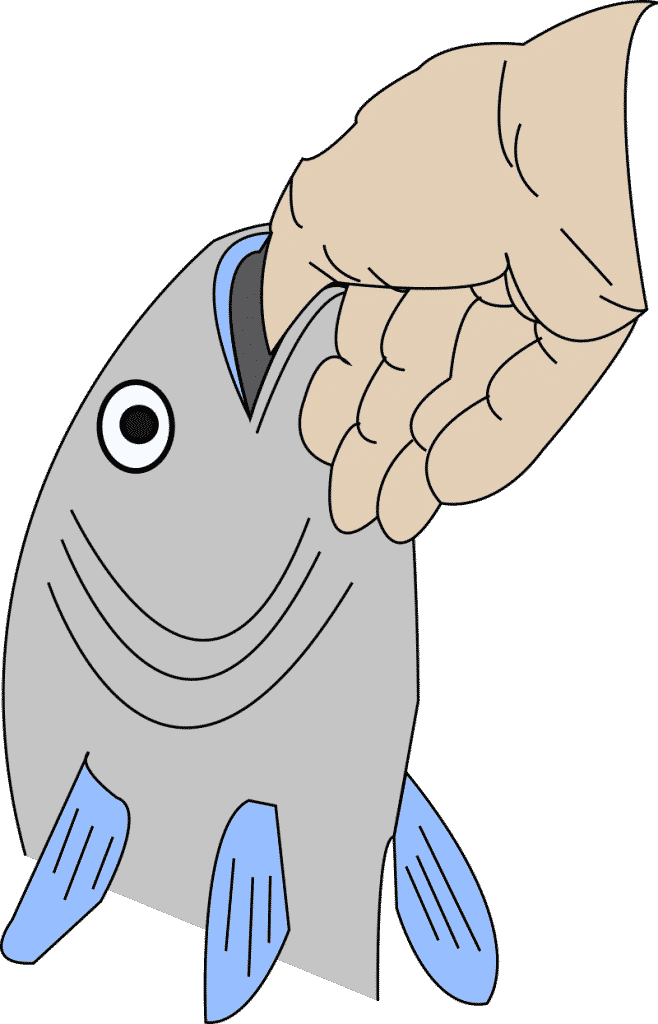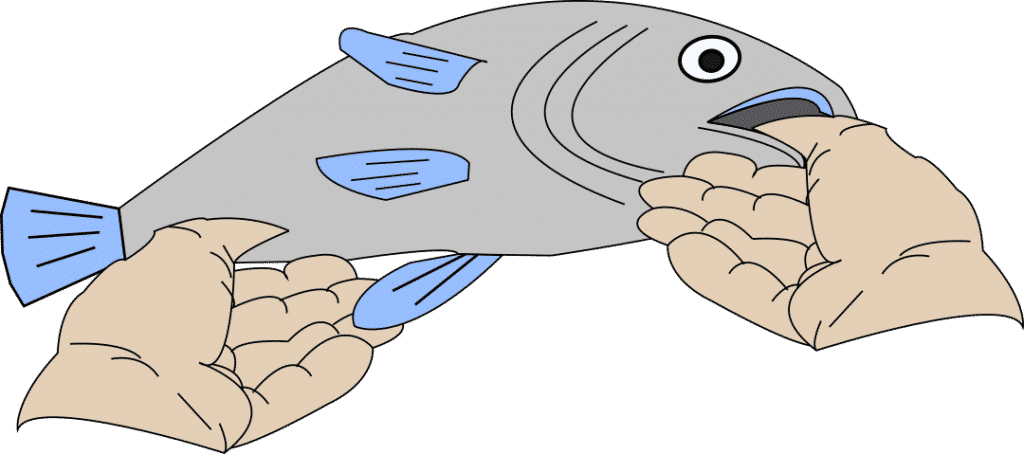Early in every fisherman’s
Every fisherman has to start somewhere and learning how to pick up a bass seems like a great place to start. What good is bringing in a fish if you don’t know how to release him.
Grabbing a Bass
Grabbing a bass by the belly is about as easy as grabbing a pissed off squirrel. Those little suckers squirm and slap you around a little bit. They’ve even got spiny fins that straight up shred your palms.
With a bass and most other soft mouthed fish you can immobilize them by grabbing them by the lower lip. Squeeze his tongue and lower lip between your thumb and forefinger.
Just keep an eye out for those extra treble hooks that are going to stick you the second he wiggles. Smallies can be held the same way even though their mouths are noticeably smaller.
Should You Wear Fishing Gloves?
Personally I’m not a huge fan of wearing gloves when bass fishing. I have a pair of gloves for when it’s particularly cold, but most days I’m glove free.(these are the gloves I use)
I’m not saying there’s anything wrong with wearing gloves, they’re even required for some species. I just always felt like I had more control gloveless.
How Do You Hold a Bass?
So now, how do you hold a bass? You’ve caught that prized bass and you’re ready to pose for a picture. There’s basically three different ways to hold a bass depending on how big he is. Heavier fish will need more support so you don’t damage their jaw.
Start By Grabbing Him By The Jaw

With a largemouth bass you always start by grabbing him by the jaw. As the name implies they have a large wide open mouth that’s easy to grab.
Make sure you grab his jaw with enough pressure so he doesn’t get away. You don’t need to have a death grip, but a really firm grip so he doesn’t wiggle out of your hands.
Do Bass Have Teeth?
Yes bass do have teeth, they’re actually pretty sharp, but you really don’t have to worry about them. Millions of fisherman across the country hold bass by their jaw everyday, with nairy an injury.
Just work him a little bit before bringing him in so he gets rid of some of that adrenaline. When they wiggle and flop around it feels like sandpaper rubbing against your thumb(not pleasant). Play them a little longer so they aren’t quite as ticked off when you grab them.
Vertical Hold

Getting bass out of the water might seem easy for experienced fisherman, but it might not come
You really just need to practice playing bass to shore and rolling him so you have easy access to the jawline. Grab his jaw with a firm grip and angle his body with his tail directly below his body.
His body should be hanging straight up and you shouldn’t feel much pressure and resistance. If you didn’t work him long enough in the water you can expect a few nice wiggles right off the bat.
How Long Can He Stay Out of The Water?
You really don’t want to keep that largemouth out of the water for long. If you’re a “catch and release” type of guy, keep him out just long enough to snap a quick picture.
If he’s big make sure your cameras ready before getting him out of the water. This is where landing nets really come in handy. You can get full control of the fish while he’s still in the water without having to worry about him getting away.(this is my favorite landing net)
Once he’s out of the water y
Watch The Angle With Larger Bass
You can safely hold smaller bass at an angle without having to worry. Holding a larger fish at steep angler can cause damage to his jaw.
Horizontal Hold

With the horizontal hold you use two hands to hold the fish sideways. I mainly use the horizontal hold to show off Largemouth Bass with unusually fat bellies. Those big bellied females right after the spawn are prime candidates for the horizontal hold.
Start off by grabbing him by the jaw the same way you would do a vertical hold. Bring him up out of the water and hold him in the vertical position so you can get your second hand in the correct position. Place your second hand directly between his tail and fin holding onto his body.
You don’t really need to have a firm grip on his body. Squeeze just enough to support his spine and take a little weight off his jaw. Doesn’t matter what size fish you’re holding the horizontal hold can support his weight.
Horizontal vs Vertical Hold
I only use the horizontal hold when I bring in a real monster bass. Fishing photography is all about shooting angle. With a vertical
Fishing photos are all about forced perspective. Learned all about this back in my
Protect That Slime Layer
Bass are covered in a thin protective layer that protects their body from disease. (actually most fish have this layer) This is the reason most fish feel a little bit slimy.
Removing this natural layer is going to put him at risk off infection. Try not to handle him more than you have to. Keep a firm grip and avoid dropping him, because wiggling on the ground will quickly wipe destroy this thin layer.
Sometimes you just can’t avoid dropping him when he starts to wiggle and writhe. If he hits the ground quickly get a hold of him and toss him back in the water as fast as possible. Snapping a quick photo isn’t worth accidentally killing the fish.

